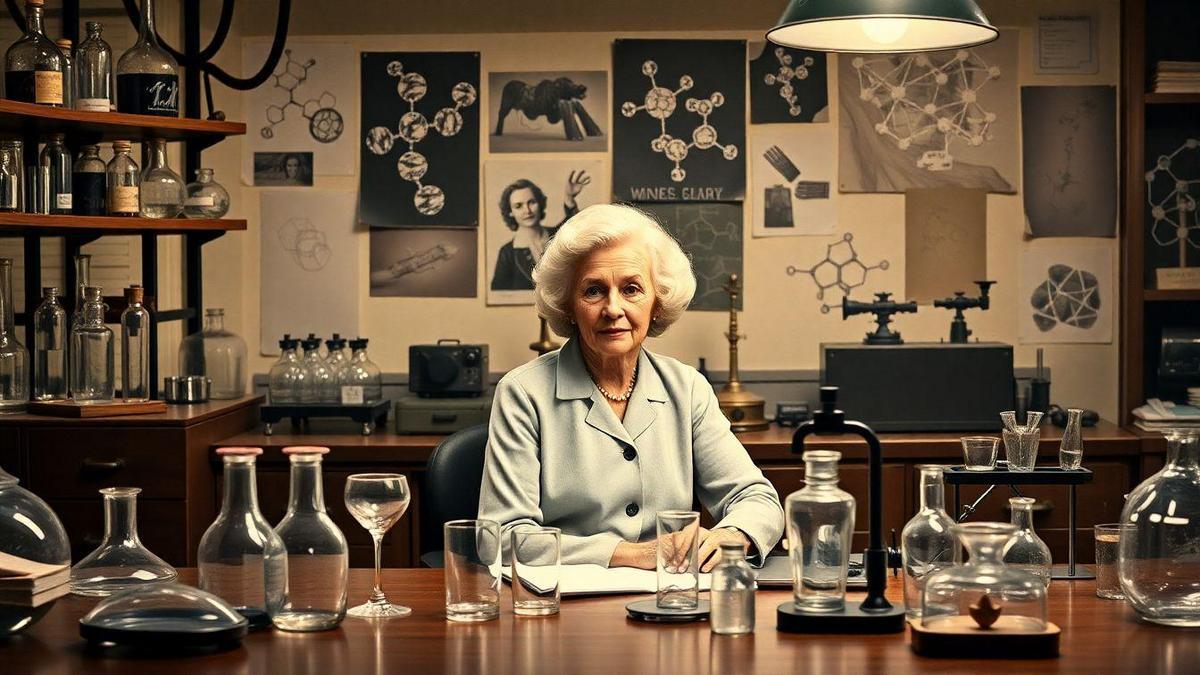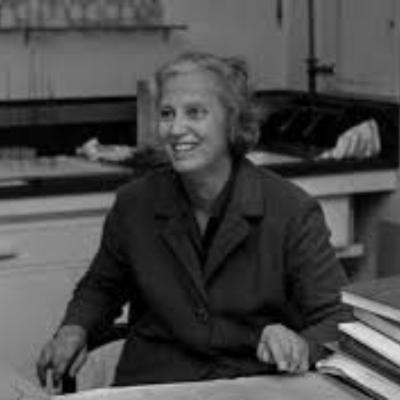Anúncios
Crystallography, as a structural analysis technique, revolutionized biochemistry, allowing scientists to decipher the complex molecular architectures of vital biomolecules. This advancement owes much to the work of Dorothy Hodgkin, whose innovations made it possible to visualize three-dimensional structures in impressive detail. Her contributions not only challenged the technological limits of her time but also changed the way we understand biological processes.
In addition to her scientific impact, Hodgkin’s work stimulated the development of new therapies and medications, bringing immeasurable benefits to medicine. Her techniques paved the way for the design of more specific and effective drugs, impacting the pharmaceutical industry and biotechnology. Crystallography, as an indispensable tool, continues to play a crucial role in biomolecular research and disease treatment.
Anúncios

The Foundation of Crystallography Techniques
X-ray crystallography is a powerful technique that allows precise determination of molecular structures. Using X-rays to analyze biomolecule crystals, scientists can deduce the position of atoms and create three-dimensional models. This process requires high-quality crystals, which can be challenging for many biomolecules.
When X-rays collide with electrons in the crystal, diffraction occurs, creating a pattern that is interpreted by computational methods. These patterns provide crucial information about the atomic arrangement in the molecule. Thus, crystallography reveals details about the interactions between molecules, essential for understanding biological processes.
Beyond traditional crystallochemistry, methods such as synchrotron radiation and cryo-electron microscopy have expanded the possibilities of crystallography. Synchrotron radiation, for example, provides more intense beams, allowing the study of smaller crystals and more complex biomolecules. Cryo-electron microscopy can visualize molecules in their native state, without the need for crystallization.
These innovations have enabled significant advances in the resolution of biological structures. They have contributed to the analysis of biomolecules that were previously impossible to study, such as proteins in their dynamic forms. This ability has allowed scientists to gain valuable insights into molecular functions and their interactions.
Dorothy Hodgkin’s Contribution to Crystallography
Dorothy Hodgkin was one of the pioneers in using crystallography to study biomolecules. Her work on the structure of penicillin was one of the first milestones in using this technique to study antibiotics. Hodgkin’s analysis was essential to understanding penicillin, revolutionizing the treatment of bacterial infections.
Hodgkin is also known for her work on determining the structure of vitamin B12, a remarkable achievement for its time. This advancement allowed a better understanding of the metabolic processes related to this vitamin. Her work on the structure of biomolecules paved the way for new studies and therapies in the field of biochemistry.
Hodgkin’s contribution was crucial to the development of more precise methods in crystallography. Her innovative approach helped overcome technical challenges and created new ways of studying complex molecules. Her dedication to scientific research and the development of techniques helped establish crystallography as an essential tool in biochemistry.
In addition, Dorothy Hodgkin had a lasting impact on promoting women in science. She broke barriers in a predominantly male field, becoming an inspiration to many scientists. Her legacy continues to be a motivating force for future generations of women in science.
The Revolution in the Study of Complex Biomolecules

With the development of crystallography techniques, the study of complex biomolecules became a reality. Structures such as proteins and nucleic acids, which were once impenetrable, could now be analyzed in detail. This enabled a deeper understanding of their functions and mechanisms.
These techniques helped reveal the three-dimensional structure of proteins, showing how they fold and interact with other molecules. Such information is essential for understanding how proteins perform their roles in biological processes, such as catalyzing chemical reactions and mediating cell signaling. Crystallochemistry became fundamental in molecular biology.
Moreover, the ability to study nucleic acids such as DNA in detail was a crucial advance. Crystallography allowed scientists to visualize the molecules that store and transmit genetic information. This had direct implications for the development of genetic therapies and disease treatments.
Another important aspect of crystallography is its application in drug design. From the structures obtained, scientists can design molecules that interact specifically with biological targets. This opened new possibilities in the development of more effective therapies with fewer side effects.
Advantages of Dorothy Hodgkin and Crystallography Techniques Revolutionizing Biochemistry
Dorothy Hodgkin’s contributions to crystallography had a profound impact on the field of biochemistry. One of the main advantages of Hodgkin’s work is the ability to elucidate the structures of vital biomolecules, such as vitamins, hormones, and antibiotics. By determining the structures of these compounds, Hodgkin laid the foundation for understanding their biological functions and mechanisms of action. This knowledge was essential for the development of new drugs and therapies, revolutionizing the pharmaceutical industry.
Another significant advantage of Hodgkin’s crystallography techniques is their applicability to a wide range of biomolecules. Her methods were used to study proteins, nucleic acids, and small organic molecules, making crystallography a versatile tool in biochemistry. This versatility allows researchers to investigate various biological systems, from enzymes involved in metabolic pathways to the structural components of DNA. The insights gained from these studies led to advances in several fields, including genetics, microbiology, and medicine.
Furthermore, Hodgkin’s pioneering work inspired generations of scientists to pursue careers in structural biology and biochemistry. Her achievements demonstrated the importance of interdisciplinary research, uniting chemistry, biology, and physics. As a result, her legacy continues to influence the training and education of young scientists, promoting a culture of innovation and collaboration in the scientific community.
In addition to her scientific contributions, Hodgkin’s advocacy for women in science had a lasting impact on the field. By breaking barriers and gaining recognition in a male-dominated discipline, she became a role model for aspiring scientists. Her commitment to promoting diversity and inclusion in STEM fields encouraged more women to pursue careers in biochemistry and related disciplines, enriching the scientific landscape.
How Dorothy Hodgkin and Crystallography Techniques Transform Scientific Research

Understanding protein structures is crucial for unraveling the complexities of biological systems. Crystallography techniques, particularly those advanced by Dorothy Hodgkin, allowed scientists to visualize the intricate architectures of proteins at atomic resolution. This understanding is fundamental for deciphering how proteins function, interact with other biomolecules, and contribute to cellular processes. By providing a clear image of protein structures, crystallography facilitates the identification of active sites, binding pockets, and conformational changes that are essential for enzymatic activity and regulation.
Advancing drug design applications is another significant benefit of crystallography techniques. By elucidating the structures of disease-related target proteins, researchers can design more effective and specific drugs. High-resolution structural information enables the rational design of small molecules that can interact with target proteins, enhancing their therapeutic potential. This approach has been instrumental in developing targeted therapies for various diseases, including cancer and infectious diseases, leading to better outcomes for patients.
Contributing to advances in molecular biology, crystallography techniques have played a vital role in understanding the structure and function of nucleic acids, such as DNA and RNA. By determining the structures of these molecules, scientists gained insights into the mechanisms of genetic information storage, replication, and expression. This knowledge has profound implications for fields like genetics, genomics, and synthetic biology, paving the way for innovative approaches in gene editing and biotechnology.
Empowering innovations in structural biology, Hodgkin’s crystallography techniques fostered the development of new methodologies and technologies. The integration of crystallography with other techniques, such as cryo-electron microscopy and NMR spectroscopy, expanded the toolkit available to researchers. This convergence of techniques enables a more comprehensive understanding of biomolecular structures and dynamics, leading to new discoveries and advances in biochemistry. As researchers continue to explore the frontiers of structural biology, the impact of Hodgkin’s work remains evident in the ongoing evolution of the field.
Supporting the determination of complex molecular arrangements is another key aspect of crystallography techniques. Many biological macromolecules exist as large complexes, and understanding their structures is essential for deciphering their functions. Hodgkin’s methods were instrumental in resolving the structures of such complexes, providing insights into their assembly, stability, and interactions. This knowledge is crucial for elucidating the mechanisms of cellular processes and developing strategies to manipulate these systems for therapeutic purposes.
By enhancing scientific contributions to biochemistry, Hodgkin’s crystallography techniques opened new avenues for research and discovery. The ability to visualize molecular structures led to a deeper understanding of fundamental biological processes, such as enzymatic catalysis, signal transduction, and cellular communication. As researchers continue to apply crystallography techniques to investigate the complexities of life at the molecular level, Hodgkin’s contributions, along with those of her contemporaries, will undoubtedly shape the future of biochemistry and related fields.
Did You Enjoy Learning About Dorothy Hodgkin and Crystallography Techniques Revolutionizing Biochemistry?
Exploring the world of Dorothy Hodgkin and her innovative crystallography techniques reveals the profound impact these methods had on biochemistry. From elucidating the structures of vital biomolecules to advancing drug design and fostering innovations in structural biology, Hodgkin’s contributions continue to resonate in the scientific community. Her legacy inspires future generations of researchers to push the boundaries of knowledge and discovery.
As we delve deeper into the intricate issues of biochemistry and structural biology, the importance of Hodgkin’s work becomes ever more evident. The techniques she pioneered not only revolutionized our understanding of molecular structures but also paved the way for new therapeutic strategies and scientific advancements. The journey of discovery in this field is ongoing, and there is still much to learn and explore.
Frequently Asked Questions
Who was Dorothy Hodgkin?
Dorothy Hodgkin was a British chemist who won the Nobel Prize in 1964. Her work with crystals revolutionized biochemistry.
What are crystallography techniques?
Crystallography techniques help study the structure of crystals. They show how atoms are organized and are essential for understanding biological molecules.
How did Dorothy Hodgkin contribute to crystallography?
Hodgkin developed new methods and unraveled the structure of important biomolecules. Her work impacted medicine and biology.
What is the importance of crystallography in biochemistry?
Crystallography is crucial in biochemistry. It helps discover how molecules work, which can lead to new drugs and treatments.
How did Hodgkin’s techniques transform science?
Dorothy Hodgkin’s techniques changed the way we study molecules, opening doors to new discoveries and revolutionizing biochemistry.
